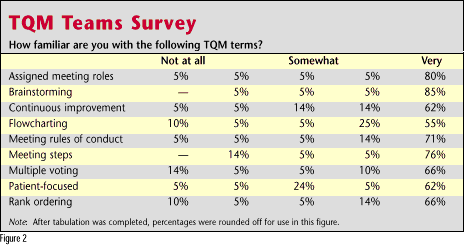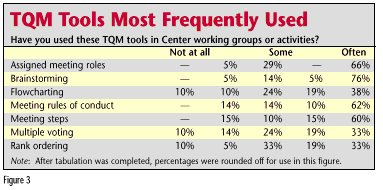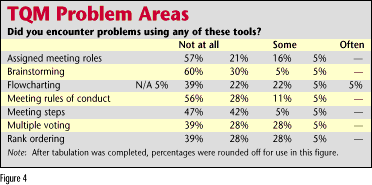


 |
|||
 |
|||
 |
|||
The use of TQM in the center's development was carefully evaluated over the past three years as the center worked toward its goals. The Evaluation Task Force sent questionnaires to center participants as part of annual center evaluations. In 1993, the questionnaires were sent to 161 participants, with a 46-percent response rate; for the 1994 evaluation, the questionnaires were sent to 114 participants, with 32 percent responding. |
||||||
 |
||||||
 |
||||||
In both surveys, five questions were asked in reference to TQM's effectiveness. Participants were asked if the Center for Healthy Communities was effective in several key TQM areas: respect for individuals, customer focus, teamwork, continuous program improvement and meeting management. A high percentage of participants agreed that TQM methods were successful in center activities. Upon investigation, the drop in the percentage viewing TQM as effective for meetings stemmed from the participants' sense that the formal process had become such a part of the culture that less formal approaches worked equally well. In the spring of 1995, the center again surveyed key participants specifically about their perspectives on using TQM in the center's program design and development. Twenty-one of 51 faculty and community representatives replied to the survey -- for a 42-percent return rate. Participants were first asked about their familiarity with TQM terms used by the Center for Healthy Communities. Although center staff focused on the technique rather than specific terms when incorporating TQM, participants responded that they were very familiar with terms such as assigned meeting roles (80%), brainstorming (85%) and meeting steps (76%). High percentages of the respondents also were very familiar with the terms continuous improvement, meeting rules of conduct, multiple voting, patient-focused and rank ordering. The term flowcharting (55%) was the least familiar of all the terms because some groups, particularly the service delivery committees, used the technique frequently, and others used it rarely. |
||||||
 |
||||||
When asked about how frequently the participants had used TQM tools in center working groups and activities, the respondents indicated that they had used brainstorming (76%) most often and multiple voting and rank ordering (33% each) least often. Respondents also indicated that the most useful tools were brainstorming (76%) and assigned meeting roles (66%). They indicated that multiple voting and rank ordering, the tools that were used the least, were also the least useful. When asked to give an example of how the techniques improved or enhanced center activities, respondents cited that the tools "allow everyone the opportunity to participate" and that "meetings were more focused, on track, productive and on time." Respondents were also asked if they encountered problems using any of these tools and, if so, to briefly explain what these were. Assigned meeting roles (57%) and brainstorming (60%) indicated they had encountered no problems at all. Twenty-one and 30 percent, respectively, indicated that they had experienced some problems using both tools. Respondents indicated that they had encountered problems most frequently using flowcharting, with only 39 percent indicating no problems, 22 percent some problems, and 5 percent frequent problems. Flowcharting was described by two respondents as "somewhat difficult for some participants to understand." Others criticized rotating roles for meetings as a "lack of continuity" and the process as "rather artificial and rigid at times." Another suggested that problems occurred when "we drift away from the process." |
||||||
 |
||||||
Conclusion For the past three years, TQM methods have guided the development of a community-academic partnership focused upon the health of the community and the education of its health care professionals. These methods have been successfully incorporated into the center's working and governing committees. Both community and academic participants have indicated high levels of knowledge and acceptance for the methods used. Although originally developed and implemented in industry, the TQM methods practiced by the Center for Healthy Communities helped in the design and implementation of programs, aided consensus and team building for community and academic partners, and gave staff a structure on which to build a shared vision.
References Berwick, D.M.; A.B. Godfrey; and J. Roessner. 1990. Curing Health Care: New Strategies for Quality Improvement. San Francisco: Jossey-Bass Publishers. Collier, J.C. August 1992. "Becoming Empowered Through TQM." Quality Digest, 2934. Collins, A. May/June 1990. "Quality Control as a Model for Education: It Would Improve Our Output." Engineering Education, 470471. Fenwick, A.C. December 1996. "Five Easy Lessons." Quality Progress, 6366. Joint Commission on Accreditation of Healthcare Organizations. 1992. Striving Toward Improvement. Oakbrook Terrace, Illinois. Kaufman, R. December 1991. "Toward Total Quality 'Plus.' " Training, 5054. Kramer, C.E. May 1993. "Improving Team Meetings." Quality Digest, 7480. Namie, G. and R.P. Neuman. August 1992. "Quality in Health Care?" Quality Digest, 2027. White, J.A. 1990. "TQM: It's Time, Academia." First National Symposium on the Role of Academia in National Competitiveness and TQM.
About the authors Cheryl A. Maurana, Ph.D., is associate professor of family and community medicine and vice chairwoman and chief of the Division of Community Health, Medical College of Wisconsin. Previously, she was associate dean for community health development, Wright State University School of Medicine, and founding director of the Center for Healthy Communities. Telephone (414) 456-8291, fax (414) 266-8537. Albert E. Langley, Ph.D., is associate dean for academic affairs and professor of pharmacology and toxicology at Wright State University School of Medicine. Telephone (513) 873-2161, fax (513) 873-3672. Kim Goldenberg, M.D., is dean and professor of medicine at Wright State University School of Medicine. Telephone (513) 873-2933, fax (513) 873-3672. Judith A. Engle, M.A., is director of the office of public relations at Wright State University School of Medicine. Telephone (513) 873-2038, fax (513) 873-3672. |
||||||
|
|
|||||||||||||||||||||||||||||||||||||||||||||